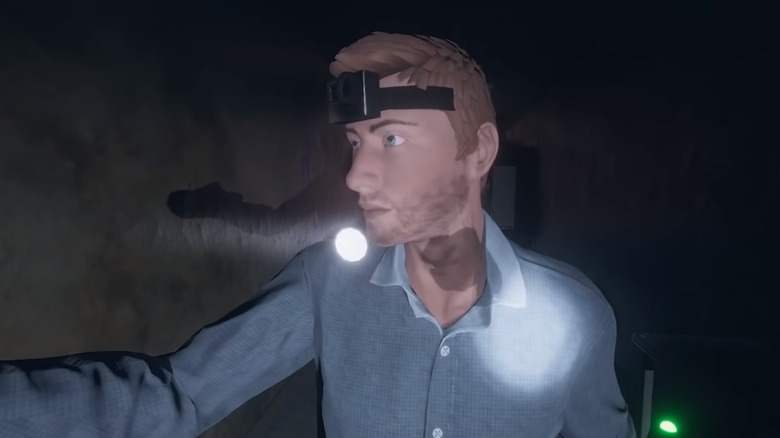What Phasmophobia's Surprise Success Means For The Future
Fall is the perfect season for enjoying horror games, especially for those who celebrate Halloween before and beyond Oct. 31. Yet, when one-man indie developer Kinetic Games released Phasmophobia for Early Access in September, it could not have predicted the game's surprisingly huge success. The co-op horror title has received a deluge of "overwhelmingly positive" reviews on Steam. Though it's only been in Steam Early Access for almost two months, the sheer number of players could mean big changes for Phasmophobia's future.
Phasmophobia is an immersive horror experience that allows gamers to play in groups of four — via VR or a standard PC setup — and investigate hauntings using paranormal tools such as EMF readers, Ouija boards, and night vision cameras. Players may feel like real-life ghost hunters as they search for clues and even talk to spirits via voice interaction, and they may witness spooky sounds and images if they anger the entity. There are 10 different possible ghost types to encounter, and it's up to the players to figure out how to exorcise the hostile presence.
In a recent interview with IGN, Kinetic Games developer Dknighter revealed Phasmophobia will spend more time in Early Access before receiving a full release. "I was originally planning the early access to be short ... where I just add a few more maps, ghost types and equipment," Dknighter explained. "However, due to the game's popularity, everyone's expectations are increased so I am going to have to reconsider my plans for the game's future."
IGN also reported there were once plans to create a PvP feature for the game, but this has since been scrapped. Dknighter went on to say that most of the work invested into Phasmophobia, at least for now, will be bug fixes and polishing, rather than adding new modes. "I want the game to remain 4 players vs. 1 AI, and balance the game, then add new features around that style of gameplay."
Early access has done wonders for some game titles over the years, allowing developers to gather feedback from players and use the monetary gain to help polish the title and make it ready for full release. Minecraft, which spent about two years in paid public alpha, serves as perhaps the most successful example. More recently, Hades – the rogue dungeon crawler — proved a big win for developers. It entered Early Access on Steam in 2018 and launched on Nintendo Switch and PC in September 2020.
Other attempts to springboard indie games via early access have not been as lucky. Notably, Earth: Year 2066 (an Early Access release in 2014) was a colossal failure, prompting Steam to remove it from the platform and give customers full refunds. The game's poor quality was bad enough, but the developer's reaction to its bad reviews — allegedly deleting negative comments on Steam forums — only made the situation worse.
Another example of a failed early access game is Spacebase DF-9, which made promises it couldn't keep and left gamers who purchased the title feeling cheated. According to an article by Polygon published in 2014, the game's developer, Double Fine, hoped to use the funds from early access to add more features to the game, which it listed for players to view in a post titled "Future Development Plans." However, these plans were dropped after the game spent nearly two years in development, and the game was shipped "as is" with bug fixes and a new tutorial, but nothing else. Fans were disappointed, to say the least, and Double Fine studio head Tim Schafer took the time to provide an explanation in a lengthy Steam forum post.
Phasmophobia seems to have a good chance of making it outside of Steam Early Access — if the numbers and positive reviews are anything to go by.

